01.11.14
'A phenomenal achievement': Manchester Metrolink's latest successful extension
Source: Rail Technology Magazine Oct/Nov 2014
Metrolink’s latest extension, to Manchester Airport, will have just opened as you open this edition of RTM. The project has been delivered more than a year ahead of schedule – how have they done it? RTM met Metrolink director Peter Cushing and spent time at Metrolink sites with Thales project director Martin Murphy, and also heard from Peter Jones, project leader at MPT, the consortium delivering the extension.
The engineers, designers, project managers and frontline personnel who have managed to bring Manchester’s light rail system’s new extension online more than a year ahead of schedule have received many plaudits in recent weeks.
Among them was the quote in the headline above from Cllr Andrew Fender, chair of the Transport for Greater Manchester (TfGM) Committee, who says the team and its contractors have become an “ultra-efficient machine”.

MPT (an unconsolidated consortium of Thales plus the M-Pact joint venture of Laing O’Rourke and VolkerRail) started work on expanding Metrolink in 2008, having begun working together to explore a Merseyrail job that never came to fruition.
The new Airport Line is the latest in a series of new lines and extensions delivered in the past three years, and MPT is also building the Second City Crossing (2CC) to boost capacity through the network’s most constrained bottleneck in the city centre.
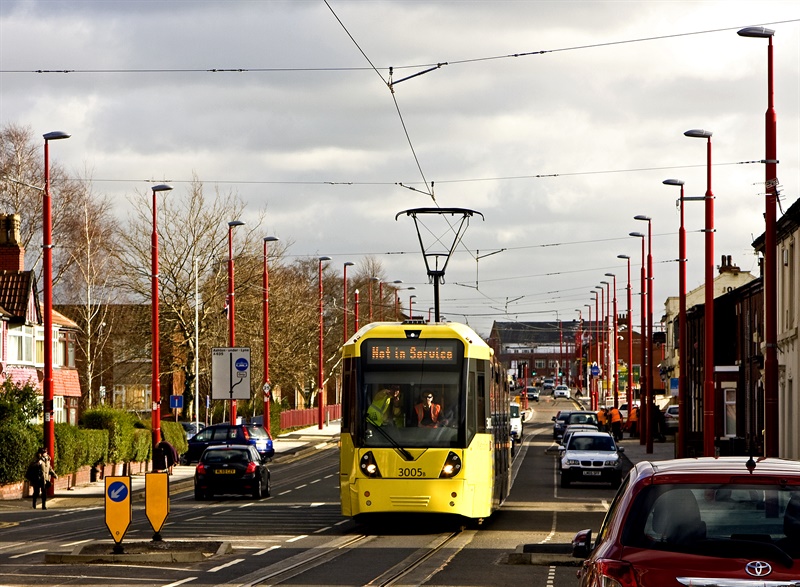
Under a separate direct contract with TfGM, Thales has also been overhauling the signalling and tram control via the implementation of its tram management system (TMS). That conversion too is reaching its final stages.
Useful experience
The 14.5km, 15-stop new Airport Line, open from 3 November, brings the size of the Metrolink network to 92.5km (57.5 miles) serving 92 stops.
Asked how the new line has been able to open in November 2014 instead of summer 2016, Metrolink director Peter Cushing, who took over early last year, told RTM: “Over the last three years, we’ve got better at delivering things. The contractors have all gained more experience and it’s been easier for them. They brought crews off the Oldham-Rochdale extension when they finished that [in March 2014], and off the East Manchester Line when they finished that [in October 2013]. They put them onto the Airport extension and have been delivering it in sections, as opposed to just having one team on the line.

“It’s enabled us to get the work done quicker. For the workforce who were on the East Manchester Line and were brought over to the Airport Line, it’s very similar – with street-running, and road junctions to deal with – so they’ve got the knowledge, they’ve got the experience, and it’s been relatively easy for them to translate from one to the other.”
Progressive improvements
Martin Murphy is project director for Thales, across both its contracts with TfGM – as part of the MPT consortium, and directly on the TMS work.
RTM met him at Thales’s offices at Trafford Plaza in Manchester, which it is soon to vacate, and went with him to meet staff at the Network Management Centre and the Trafford tram depot.
Asked about the early completion of the latest extension, Murphy said: “It’s not often that you get the opportunity to understand the improvements and the lessons learned on previous lines and bring that experience straight into play on another project.”
He noted that there were “negative public perceptions” when some of the earlier line extension openings were delayed. “But as we have progressed, we have progressively improved on the public opening dates,” he said.
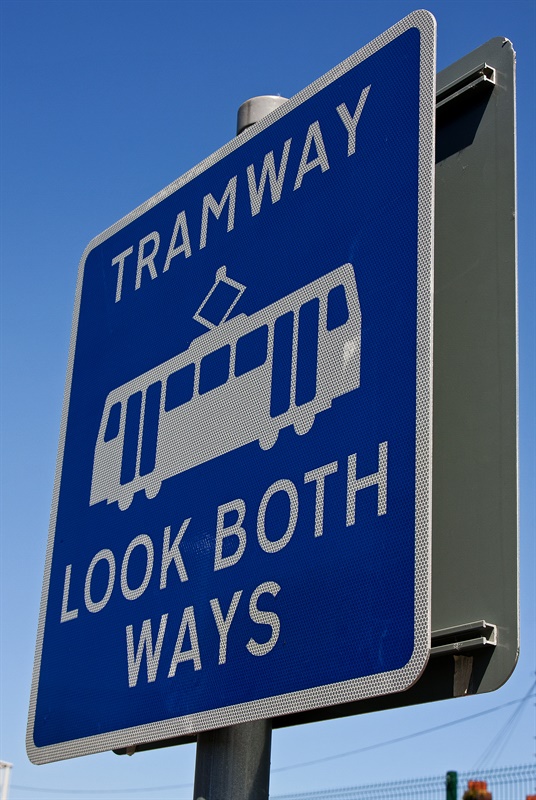
The line extensions to both Ashton and Didsbury were completed ahead of schedule, for example, which freed up workers and resources to join the Airport Line sites.
Murphy has been on the Manchester job for about three years, having come from the military technology side of Thales’ business, and said some of the senior managers at both the client and contractors have been there since the very start. “It’s all been relatively stable,” he said. “You develop new ways of working and innovations that allow you to save time – and we really reaped the benefit of that on the Airport Line.”
Lessons learnt and multiple worksites
Lessons have included the interfaces with Urban Traffic Control (UTC, the network of traffic signals across the city), using a wireless mesh arrangement rather than fixed loops in the ground, plus optimising the handling of uncharted utilities – a major risk factor that can be a significant source of delay. “We picked up on the lessons, no matter how small, that we’d learnt from the previous lines – and then it was a matter of resource planning,” Murphy said.
Peter Jones, project leader at MPT, said experience had improved everything from design processes to integration to the handover management plans.
Murphy added: “From a Thales perspective, one of the most challenging aspects has been working across multiple sites at once. We probably have three or four sites on at any given time. Not only are we looking at the ‘phase 3’ network expansion – the ‘greenfield’ part – we’re also doing the ‘brownfield’ conversion of the existing fixed block signalling system to TMS. We’ve managed to inter-weave that conversion programme in with the overall delivery of the Airport Line.”
Cushing called the Airport extension “a really complex piece of work”, with lots of roadwork and a need for co-ordination with Manchester City Council and the highways teams. The teams delivering the extension work “hand in glove”, Cushing said, and all operate as a single integrated delivery team.

Jones added: “The major beneficiary of an integrated delivery approach is the project itself in that being truly integrated means that each party is fully aligned to shared objectives and employs a ‘project first’ approach to the challenges faced. The very nature of being integrated generates effective communication at all levels, resulting in better understanding of issues, impacts and risks when seeking solutions – and this can only lead to improved awareness and better outcomes for the project as a whole.”
Readiness programme
Cushing discussed the fortnightly integrated programme meetings running through upcoming milestones and risks. “We don’t run it as TfGM and then tell them what we’re doing – everybody is in the room,” he said.
On top of this, 16 weeks out from going live on the Airport Line, a readiness programme including everything yet to be delivered was instituted. That programme was refreshed monthly at first, then fortnightly, then weekly, and in the final two weeks before go-live it was daily.
Cushing said: “People from site level to senior level – everyone has sight of it and sees what’s happening. Predominately, it is about the guys at the coalface: they’ve got to check dates and actions. It’s their own team who have set that programme. We’re not telling them when we want it done: they set the programme and know what they can do, and manage it to those milestones.”

Murphy said these meetings help ensure specific blockers to progress are tackled early, whether they be technical or resource-driven. “Sometimes that means calls have to be made for the overall greater good of the programme,” he said. He told us that Thales itself has about 250 staff across the MPT and TMS programmes, some of whom are flexible and work across both types of worksites, while the design teams are usually separate as they employ specialist skills.
On MPT, Thales’s core responsibility is power: the high-voltage power systems, the overhead lines, the traction power substations, electrical distribution, low-voltage power and tram stop fit-outs, the operational radio system, and so on.
Regeneration and renewal
The airport extension, which branches off the current line between the city centre and Didsbury, via Wythenshawe, is hoped to have major effects on regeneration and in boosting the economy, especially around the new £800m Airport City Manchester industrial and business development.
Cushing said: “If this extension does anything like what we’ve seen with the Oldham town centre extension – if it has anything like that impact – it can only help in regenerating the centre of Wythenshawe, with benefits for everybody concerned.”
Metrolink is also a particularly accessible option for people with mobility issues, who might have previously found it difficult or impossible to make some journeys in the area or into the city centre.
Fleet and drivers
Metrolink’s new fleet of M5000 trams, part of the Flexity Swift family, built by Bombardier and Vossloh Kiepe in Germany and Austria, have now completely replaced the old white and turquoise T-68 model. The fleet for the whole network will total 120 trams once all are delivered, with nine required to serve the Airport Line.
Sixty new drivers have been recruited, with the total now at more than 300. Eventually, all of them will be training to drive anywhere on the network, giving “total flexibility”, Cushing said.

They are trained on a custom-built simulator system, designed to run on desktop computers – far cheaper than a ‘cab simulator’ system. “We replicate the power handle of the tram with a joystick. It’s all very simple and we can train 10 drivers at a time, with a trainer on a central module who can monitor what they’re doing and give them feedback through headphones. Effectively we’ve bought a simulator package for a fraction of the cost of a traditional simulator, which might cost £1m-plus, and it’s cut out 50% of the driver training time.”
More frequent trams
TMS is now live on most lines. RTM visited the Network Management Centre (which opened without a hitch in spring 2013) the week before a vital commissioning of the new signalling and control system at Irk Valley – the junction between the Bury and Rochdale lines. The line controllers there from MRDL enthusiastically discussed the benefits of TMS on reducing task complexity, increasing oversight and tram throughput across the network whist facilitating its dramatic and rapid expansion.

Still to come during 2015 and 2016 are the migration of the Queens Road depot to TMS (the sheer number of potential moves for trams here make it a complex job), the closing out of the rest of the Bury Line and the stretch from Timperley to Altrincham, where the infrastructure is shared with Network Rail.

The travelling public get to see exactly when TMS goes live at their stop, because the passenger information displays (PIDs) start working. The automated and line-of-sight elements of TMS allows much more frequent trams, as they can run much closer together and can pull up behind each other where necessary – rather than always having to wait for the tram in front to clear a block section.
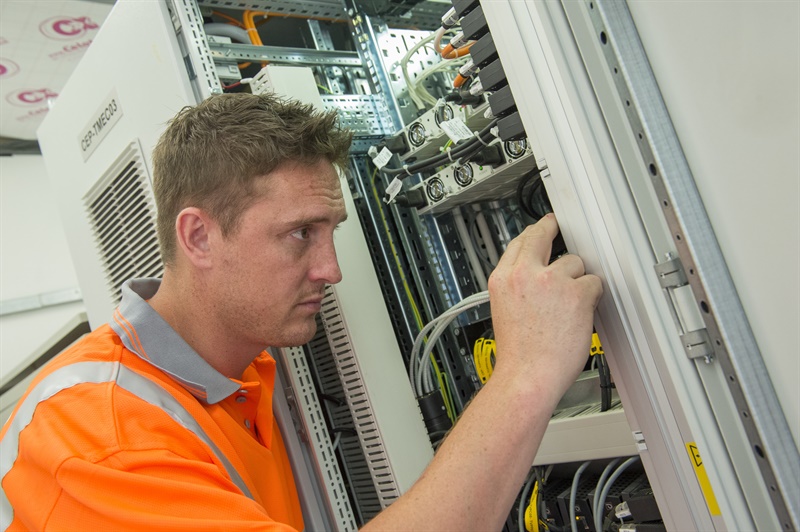
Resolving the commercial dispute
The TMS had problems in the beginning, and caused delays to the rest of the infrastructure delivery, with issues during its development and installation from 2008-12, and even a court case and independent adjudication over costs between TfGM and Thales.
But that is a thing of the past, insisted Cushing. “It’s a new signalling system so there are still some teething problems, but nowhere near where they were. We’ve ironed out a lot of the bugs and we’re on the road to moving on.”
Murphy agreed, saying: “It’s a £1.6bn project. On all such large programmes, you’re going to have issues. I don’t know of a more complex tram network.
“Throughout 2011-12, we needed to work with TfGM to reconcile the differences between how the network has been built, how the operator now wants to operate it, and what we had originally been asked to do. Whilst we had commercial issues, we divorced those from resolving the [technical] issues. We didn’t strangle our team with those commercial issues, we worked with the customer to sort the problems, and discussed the commercial side in parallel. That’s the commitment Thales gave TfGM, and all the issues were resolved.”
The problems were often not systemic, but site-specific, to do with the length of platform infrastructure or the line of sight on certain stretches. But the hard work resolving those technical and commercial issues in 2011-12 had a direct positive effect on the commissionings and extensions in 2013 and 2014, Murphy said.
True and honest relationships
Jones of MPT added: “There is no doubting that periods of conflict and negotiation can test the strength of collaborative working relationships, but if these relationships are built on trust and mutual respect, even the most challenging of situations can be resolved amicably and professionally. The difficulty in most projects is having the time necessary to develop true and honest relationships based on trust, as this cannot be gained overnight. A key factor that truly generates collaborative relationships is the behaviour of individuals. Selecting teams of individuals who continuously display collaborative behaviours and attitudes can enable positive and strong working relationships to develop at a faster pace, thus equipping the team as a whole to face more challenging situations when the need arises.”
Murphy said that TMS is now proving invaluable. “The TMS did have teething problems, but there’s absolutely no doubt that it adds a lot of value to TfGM. You only need to see the frequency of trams going in and out of Cornbrook – 40 an hour. The old system just couldn’t have done that. The overall throughput we’re now getting with TMS is fantastic.
“It does automatic routing, automatically setting the junction priorities for the trams, and so takes a lot of work away. We’ve got about 25 rail junctions and about 100 road junctions to deal with.
“It integrates with the timetable system, gives you headway control, links with the PA systems, and there is an overall supervisory system. It is integrated with SCADA control, it controls all the traction power substations and ancillary elements, all the tram stop systems. It’s not just about points! There’s a whole package there.We effectively supply the brains of the overall system, we provide the critical technology, and we hope to harness that and remain a trusted partner of TfGM into the future.”
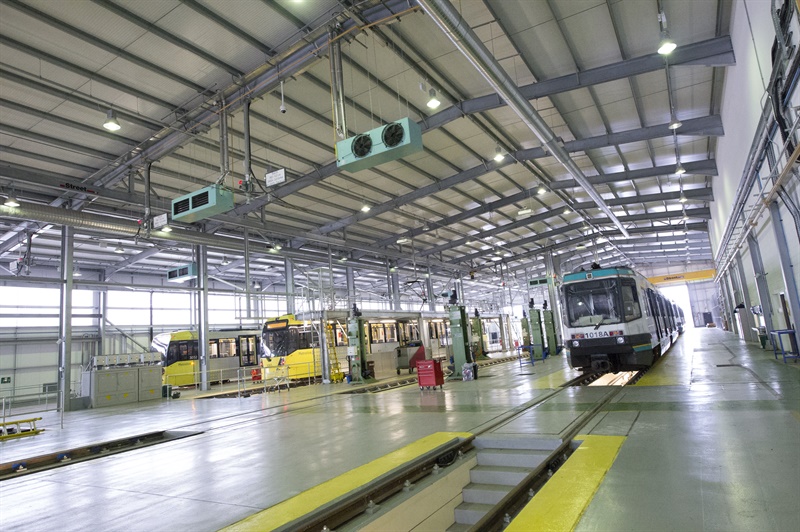
Ticketing
TfGM is also implementing a new smartcard system called ‘Get Me There’ across its transport networks, which it says will make public transport a faster, easier and more flexible option. The ‘touch-in, touch-out’ system will be the most sophisticated of its kind in the country, TfGM say, and the first of its kind in terms of what it’s expected to do.
As there are no ticket gates at the tram stops, fare dodging is a problem. The Oldham Evening Chronicle recently reported that on one tram, 85% of passengers (mostly college students) had no ticket. Inspectors boarding the trams to check tickets can issue £100 fines, cut to £50 if paid promptly, and prosecutions follow if fines go unpaid. The overall fare dodging rate is about one in 40, Metrolink had said. Cushing has said that it is no different from any other theft, and it must be tackled.
The future network
The Airport Line is the final extension of the current phase, although there are as-yet unfunded plans for another extension westwards to the Trafford Park industrial area and Trafford Centre shopping precinct.
A public consultation on that plan has just finished. “If we got funding now, we could start work in 2016 and be open by 2020,” Cushing told us, while Murphy said the arguments for the new line look “compelling”.
Plans for further extensions to Marple and Stockport are at an even earlier stage. Any extension could involve the use of tram-trains, with light rail vehicles using the heavy rail infrastructure before switching to on-street running in the city centre.
An ongoing major infrastructure development is the ‘second city crossing’ or 2CC, which will allow higher tram frequencies on many routes, typically every six minutes instead of 12.
The city centre is currently a major bottleneck for trams, but the second line through its streets, preparatory work for which has started this year, will alleviate many of those problems.
There are already agreements to use buildings instead of gantry posts in the city centre to suspend the overhead lines, cutting down on street clutter, while work on the new Exchange Square stop is being accelerated thanks to European funding, which has also provided money to improve the Deansgate-Castlefield stop and urban realm.
But 2CC is the last project that MPT will work on under the current contract – any future work will likely have to go out to the market, as will the contract to maintain the system after 2017.
Murphy told us: “That’s something we’re going to be very interested in, and we can add a lot of value. We’ll have to demonstrate our value through a competitive process and I’m looking forward to that.
“Personally, I think MPT has been a very effective vehicle for the delivery of the programme so far.”

The value of tram systems
Cushing said: “This year we’ll hit 30 million journeys a year – we’re carrying 50% more passengers than we were five years ago – and that’s still continuing upward. But there are currently restrictions through Victoria [while that station is rebuilt by Morgan Sindall and Network Rail], restricting growth to some extent.
“We can’t go to the full service offering we want to go to until we get the 2CC built, when we can start to provide six-minute frequencies to most destinations. That will drive patronage again, because frequency attracts people.”
He thinks Metrolink’s success in getting cars off the roads helps to highlight the value of tram systems, and makes it easier to argue for further extensions. “Imagine tipping 30 million people a year onto the roads – whether in buses or not. The system couldn’t cope with it. It does attract a lot of people and gets a lot of cars off the roads.”

Recognition and knowledge sharing
Metrolink has won a whole host of awards over the last six years, many of which are on display at the TfGM offices at Piccadilly Place where RTM met Cushing. Most recently, at the 2014 Light Rail Awards on 1 October, it took the ‘Most Improved System’ prize.
Asked about sharing the team’s knowledge and best practice with other light rail infrastructure projects, Cushing told us: “We do spend a lot of time with the guys in Birmingham and Nottingham, for example, we share ideas. We’re not the only place that comes up with good ideas. It’s really useful to spend time with them.
“We also have European and global visitors – Singapore, Malaysia, Frankfurt, Denmark, Sweden – there’s a lot of interest.”
In September, light rail experts from across Europe visited Manchester to explore the safety aspects of Metrolink’s operations as part of a project called ‘Operation and safety of tramways in interaction with public space’, funded by European Cooperation in Science and Technology (COST).
Maarten Duhoux from STIB, Brussels’ public transport operator, said: “The Metrolink network has grown beautifully over the last 20 years and has exciting plans to develop further. It is an excellent example of how a tramway can be a regional express network, eliminating transfer times by running into and through the city centre.”
Peter Jones put it this way: “We have been fortunate that within MPT we have several individuals with many years of light rail experience from earlier UK schemes and we were able to support this, where appropriate, with in-house expertise from heavy rail. The project has been recognised within the industry as being a significant success story and this is a testament to the people who have worked on it from all parties design, contractor, client and operator.
“We would hope that our collaborative ‘project first’ approach, backed by strong innovative engineering techniques and meticulous programming expertise, is acknowledged as a ‘blueprint’ for future projects in any sector.”
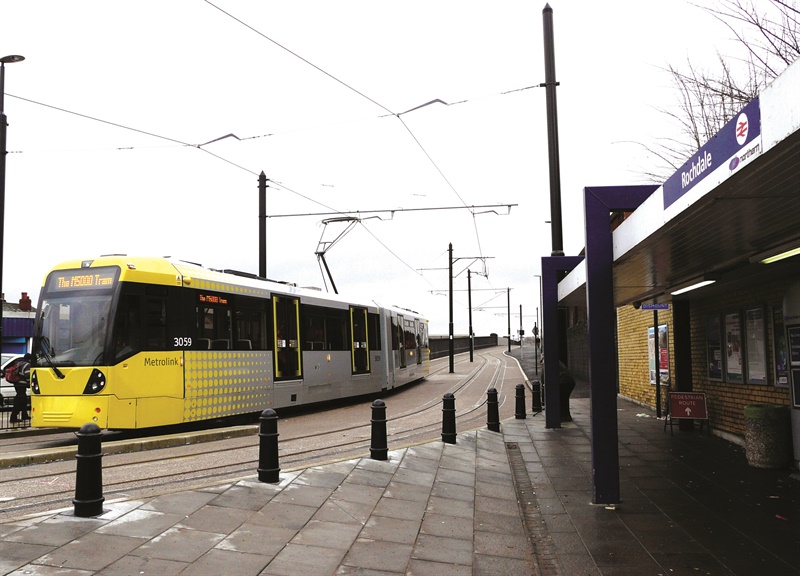
Intelligent infrastructure
Thales is the biggest supplier to Network Rail of intelligent infrastructure, Murphy said. That portfolio is managed out of its office at Cheadle, near Manchester, and Thales has been suggesting a trial of some of the latest technology with TfGM.
That trial would revolve around preventative maintenance of points, using remote monitoring technology from the heavy rail network. That work with Network Rail was the 2013 ‘Project of the Year’ in the Real IT Awards.
Thales piloted the system between Edinburgh and Glasgow in 2009, and since its national roll-out, 15,000 site visits a year have been removed as the system remotely monitors more than 32,000 assets. Network Rail calls it “a clever mix of technology, business processes and information systems that makes it possible to detect and fix emerging faults on the railway infrastructure before a failure occurs”.
RTM will report on any Metrolink trial of such a scheme in a future edition.
Safety
Martin Murphy told us: “Thales has done over 2 million hours on this project and M-Pact Thales 13.3 million to September this year.
“We work against an aggressive schedule. What we do is complex; we do it at night and on construction sites, we’re working with high voltage power at times, we’re conducting dynamic tests, working near trams, and some of our work sites are close to live environments.
“Overall the work we do is relatively high risk. The most important thing we do is manage the safety of the team. There’s enormous energy coming from the industry and the project but particularly from us at Thales to ensure that safety – it is our number one priority and truly embedded throughout our organisation. We are pleased with the safety record. We have delivered these works safely and without any major health and safety incidents against a background of multiple risk factors.
“There was a culture at the start of the programme of ‘near misses’, which has very negative connotations, so we’ve changed the language to ‘hazards’. We give people tough targets to identify hazards, with a view to mitigating and removing them. Then we’ve gradually built up the overall behavioural safety aspect, and the personal accountability elements, which have helped to embed a more positive reporting culture. As an overall Metrolink family, and from Thales within it, there is a very strong safety culture within the team.”
Stand out project
Asked for a moment from the Airport Line extension project that really stood out for him, Peter Jones of MPT told RTM: "The construction consisted of many varied and complex challenges, ranging from new bridges over the M56 and M60 motorways – both of which were installed so smoothly that each of the motorways were re-opened to traffic significantly ahead of schedule – to the complete re-construction of the urban realm and highway configuration within densely populated areas of Greater Manchester to facilitate the introduction of the new tramway at street level."
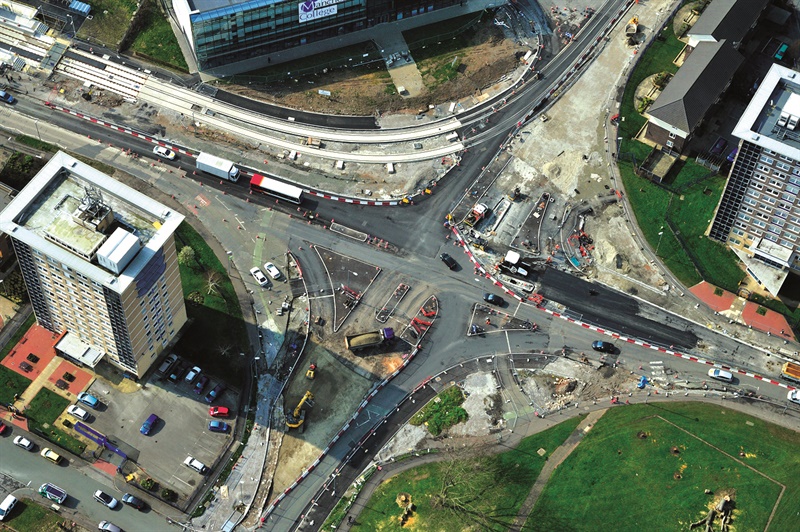
He continued: "One piece of work that does stand out is the reconstruction of Outwood Lane bridge and construction of additional platform infrastructure for Network Rail at Manchester Airport station, which becomes a fully integrated transport interchange as part of the development of Metrolink and Network Rail’s Northern Hub development programme.
"Outwood Lane is the dual carriageway access into the Manchester Airport terminals, and the project team had to tackle the logistical and technical challenge of demolishing an existing highway bridge above the railway, and constructing a new wider structure within very tight timescales for both road and railway closures. The works were successfully delivered ahead of programme to the delight of both Network Rail and Manchester Airport Group."



Above: Martin Murphy, Thales; Peter Jones, MPT; and Peter Cushing, TfGM Metrolink director)
Tell us what you think – have your say below or email [email protected]
(Images courtesy TfGM / Thales / other sources)